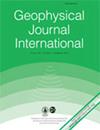马尔马拉地区北安那托利亚断层亚平行带的滑动划分
IF 2.8
3区 地球科学
Q2 GEOCHEMISTRY & GEOPHYSICS
引用次数: 0
摘要
马尔马拉地区拥有土耳其大部分居民,占伊斯坦布尔、布尔萨和科恰埃利等城市总人口的30%以上。这个地区过去经历过几次大地震,未来仍面临破坏性地震的威胁。在那里,亚平行的北安那托利亚断层(NAF)延伸到该地区,将地震的危险分布在整个地区。因此,研究构造过程如何在这些亚平行链之间分布,以区分它们各自的地震危险性是一个关键问题。在这种情况下,我们使用GPS滑动率来量化断层系统次平行链的滑动划分。除了Bulut等人(2019)和Kreemer等人(2014)编制的可用滑动率外,我们还分析了71个GPS站点(51个连续站点和20个基于活动的站点),以加强该地区的GPS网络。GPS观测显示北、中、南三股的滑移率分别为81.7%、7.7%和10.7%。对马尔马拉西部地区四个连续GPS站的时间序列分析也证实了这些比率。本文章由计算机程序翻译,如有差异,请以英文原文为准。
Slip Partitioning Across Subparallel Strands of the North Anatolian Fault in the Marmara Region
Summary Marmara Region hosts a substantial part of the inhabitants in Turkey, more than 30% of the total population in the cities of Istanbul, Bursa, and Kocaeli. This region has experienced several large earthquakes in the past and is still under threat of destructive earthquakes in the future. There, subparallel strands of the North Anatolian Fault (NAF) expand into the region, distributing the earthquake hazards across the whole region. Thus, it is a key issue to investigate how the tectonic process is distributed between these subparallel strands to discriminate their individual earthquake hazards. In this context, we used GPS slip rates to quantify the slip partitioning of the subparallel strands of the fault system. In addition to available slip rates compiled by Bulut et al. (2019) and Kreemer et al. (2014), we analyzed 71 GPS sites (51 continuous and 20 campaign-based) to intensify the GPS network in the region. GPS observations reveal 81.7%, 7.7%, and 10.7% slip ratios for northern, middle, and southern strands. Time series analysis for four continuous GPS stations in the western Marmara Region also confirms these ratios.
求助全文
通过发布文献求助,成功后即可免费获取论文全文。
去求助
来源期刊

Geophysical Journal International
地学-地球化学与地球物理
CiteScore
5.40
自引率
10.70%
发文量
436
审稿时长
3.3 months
期刊介绍:
Geophysical Journal International publishes top quality research papers, express letters, invited review papers and book reviews on all aspects of theoretical, computational, applied and observational geophysics.
 求助内容:
求助内容: 应助结果提醒方式:
应助结果提醒方式:


